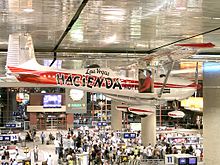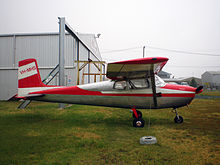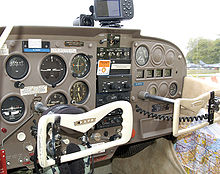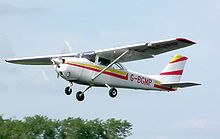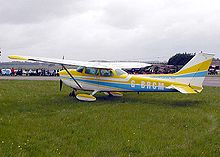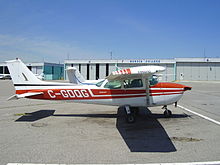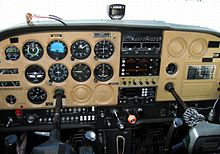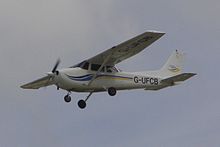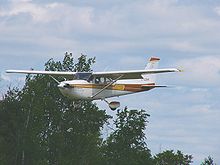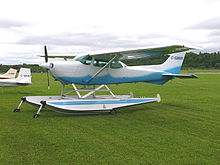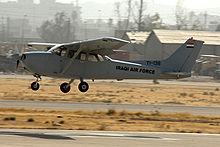- Cessna 172
-
Cessna 172 Skyhawk Cessna 172M Role Civil utility aircraft National origin United States Manufacturer Cessna Aircraft Company Introduction 1956 Number built 43,000+[1] Unit cost 172 USD$8,700 (1956)[2] Developed from Cessna 170 Variants T-41 Mescalero The Cessna 172 Skyhawk is a four-seat, single-engine, high-wing fixed-wing aircraft. First flown in 1955 and still in production, more Cessna 172s have been built than any other aircraft.
Contents
Design and development
Measured by its longevity and popularity, the Cessna 172 is the most successful mass produced light aircraft in history. The first production models were delivered in 1956 and they are still in production. As of 2008, more than 43,000 had been built.[1] The Skyhawk's main competitors have been the Beechcraft Musketeer and Grumman AA-5 series (neither in production), the Piper Cherokee and, more recently, the Diamond DA40.
The Cessna 172 started life as a tricycle landing gear variant of the taildragger Cessna 170, with a basic level of standard equipment. In January 1955 the company had flown an improved variant of the Cessna 170, a Continental O-300-A powered Cessna 170C with a larger elevator and more angular vertical tail.[4] Although the variant was tested and certified, Cessna decided to modify it with a tricycle landing gear and the modified Cessna 170C flew again on 12 June 1955.[4] To reduce the time and cost of certification the type was added on to the Cessna 170 type certificate as the Model 172.[4] Later the 172 was given its own type certificate 3A12.[5][6] The 172 became an overnight sales success and over 1,400 were built in 1956, its first full year of production.
Early 172s were similar in appearance to the 170, with the same straight aft fuselage and tall gear legs, although the 172 had a straight vertical tail while the 170 had a rounded fin and rudder. Later 172 versions incorporated revised landing gear and the sweptback tail which is still in use today. The final aesthetic development in the mid-1960s, was a lowered rear deck that allowed an aft window. Cessna advertised this added rear visibility as "Omni-Vision" . This airframe configuration has remained almost unchanged since then, except for updates in avionics and engines, including the Garmin G1000 glass cockpit in 2005. Production had been halted in the mid-1980s, but was resumed in 1996 with the 160 hp (120 kW) Cessna 172R Skyhawk and was supplemented in 1998 by the 180 hp (135 kW) Cessna 172S Skyhawk SP.
Modifications
The Cessna 172 may be modified via a wide array of Supplemental Type Certificates, including increased engine power and higher gross weights. Available STC engine modifications increase power to 180 to 210 hp (134 to 157 kW), add constant speed propellers, or allow the use of automobile gasoline. Other modifications include additional fuel tank capacity in the wing tips, add baggage compartment tanks, add wheel pants to reduce drag, or enhance landing and takeoff performance and safety with a STOL kit.[7]
Operational history
On December 4, 1958 Robert Timm and John Cook took off from McCarran Airfield, Las Vegas, NV in N9172B. Sixty-four days, 22 hours, 19 minutes and 5 seconds later, they landed back at McCarran Airfield on February 4, 1959. The flight was part of a fund raising effort for the Damon Runyon Cancer Fund. Food and water were transferred by matching speeds with a chase car on a straight stretch of road in the desert, and hoisting the supplies aboard with a rope and bucket. Fuel was taken on by hoisting a hose from a fuel truck up to the aircraft, filling an auxiliary belly tank installed for the flight, pumping that fuel into the aircraft's regular tanks, and then filling the belly tank again. The drivers steered while a second person matched speeds with the aircraft with his foot on the vehicle's accelerator pedal.
Engine oil was added by means of a tube from the cabin that was fitted to pass through the firewall. Only the pilot's seat was installed. The remaining space was used for a pad on which the relief pilot slept. The right cabin door was replaced with an easy-opening, accordion-type door to allow supplies and fuel to be hoisted aboard. Early in the flight, the engine driven electric generator failed. A Champion wind driven generator (turned by a small propeller) was hoisted aboard, taped to the wing support strut, plugged into the cigarette lighter socket—and served as the aircraft's source of electricity for the rest of the flight. The pilots decided to end the marathon-flight because, with 1558 hours continuous running during the record-setting flight plus several hundred hours already on the engine beforehand (considerably in excess of its normal overhaul interval), the engine's power output had deteriorated to the point that they were barely able to climb away after refueling. The aircraft is on display in the passenger terminal at McCarran International Airport. Photos and details of the record flight can be seen in a small museum on the upper level of the baggage claim area.[8]
Variants
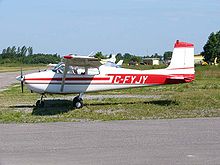 Early Cessna 172s, like this 1957 model, had a "fastback" tail with no rear window and featured a "square" fin design.
Early Cessna 172s, like this 1957 model, had a "fastback" tail with no rear window and featured a "square" fin design.
- 172
The basic 172 appeared in November 1955 as the 1956 model and remained in production until replaced by the 172A in early 1960. It was equipped with a Continental O-300 145 hp (108 kW) six-cylinder, air-cooled engine and had a maximum gross weight of 2,200 lb (998 kg). Introductory base price was USD$8995 and a total of 4195 were constructed over the five years.[9]
- 172A
The 1960 model 172A introduced a swept back tail and rudder, as well as float fittings. The price was USD$9450 and 1015 were built.[9]
- 172B
The 172B was introduced in late 1960 as the 1961 model and introduced a shorter undercarriage, engine mounts lengthened three inches (76 mm), a reshaped cowling and a pointed propeller spinner.[10] For the first time, the "Skyhawk" name was applied to an available deluxe option package. This added optional equipment included full exterior paint to replace the standard partial paint stripes and standard avionics. The gross weight was increased to 2,250 lb (1,021 kg).[9]
- 172C
The 1962 model was the 172C. It brought to the line an optional autopilot and a key starter to replace the previous pull-starter. The seats were redesigned to be six-way adjustable. A child seat was made optional to allow two children to be carried in the baggage area. The 1962 price was USD$9895. A total of 889 172C models were produced.[9]
- 172D
The 1963 172D model introduced the lower rear fuselage with wraparound Omni-Vision rear window and a one-piece windshield. New rudder and brake pedals were also added. 1146 172Ds were built.[9]
1963 also saw the introduction of the 172D Powermatic. This was equipped with a Continental GO-300E producing 175 horsepower (130 kW) and a cruise speed 11 mph (18 km/h) faster than the standard 172D. In reality this was not a new model but was a Cessna 175 Skylark that had been renamed for its last year of production. The Skylark had gained a reputation for poor engine reliability and the renaming of it as a 172 was a marketing attempt to regain sales through rebranding. The move was not a success and neither the 1963 Powermatic nor the Skylark were produced again after the 1963 model year.[9][11]
- 172E
The 172E was the 1964 model. The electrical fuses were replaced with circuit breakers. Gross weight was increased to 2,300 lb (1,043 kg) where it would stay until the 172P. The 172E also featured a re-designed instrument panel. 1401 172Es were built that year as production continued to increase.[9]
- 172F
The 1965 model 172F introduced electrically operated flaps to replace the previous lever-operated system.[5] It was built in France by Reims Cessna as the F172 until 1971. These models formed the basis for the US Air Force's T-41A Mescalero primary trainer.
A total of 1436 172Fs were completed.[9]
- 172G
The 1966 model year 172G introduced a more pointed spinner and sold for USD$12,450 in its basic 172 version and USD$13,300 in the upgraded Skyhawk version. 1597 were built.[9]
- 172H
The 1967 model 172H was the last Continental O-300 powered model. It also introduced a shorter-stroke nose gear oleo to reduce drag and improve the appearance of the aircraft in flight. A new cowling was used, introducing shock-mounts that transmitted lower noise-levels to the cockpit and reduced cowl cracking. The electric stall warning horn was replaced by a pneumatic one.
The 1967 model 172H sold for USD$10,950 while the Skyhawk version was USD$12,750. 839 were built that year, representing the first year that production was less than the year before.[9]
- 172I
 The 1968-built Cessna 172I introduced the Lycoming O-320-E2D engine of 150 hp (112 kW)
The 1968-built Cessna 172I introduced the Lycoming O-320-E2D engine of 150 hp (112 kW)
The 1968 model marked the beginning of the Lycoming powered 172s. The familiar 172 needed to be re-engined because Cessna had cancelled its contract with Continental for their venerable O-300 6-cyl engine of 145 hp (108 kW).[citation needed]
The "I" model was introduced with a Lycoming O-320-E2D engine of 150 hp (112 kW), an increase of 5 hp (3.7 kW) over the Continental powerplant. The increased power resulted in an increase in optimal cruise from 130 mph (209 km/h) TAS to 131 mph (211 km/h) TAS. There was no change in the sea level rate of climb at 645 ft (197 m) per minute.
The 172I also introduced the first standard "T" instrument arrangement. The 172I saw an increase in production to record levels with 1206 built.[9]
- 172J
The Cessna Company planned to drop the previous 172 configuration for the 1968 model year and replace it with a cantilever-wing/stabilator configuration that would be the 172J. However, as time for model introduction neared, those dealers who were aware of the change began applying pressure on the factory to continue the previous configuration. They felt the new model would be less usable as a trainer. Consequently, and at the last minute, the decision was made to continue the 172 in its original configuration. The planned 172J configuration would be introduced as a new model, the 177. The deluxe option would become the 177 Cardinal. The "J" designation was never publicly used.
- 172K
The next model year was the 1969 "K" model. The 1969 172K had a redesigned vertical fin cap and reshaped rear windows. Optional long range 52 US gal (197 l) wing fuel tanks were offered. The rear windows were slightly enlarged by 16 square inches (103 cm2). The 1969 model sold for USD$12,500 for the 172 and USD$13,995 for the Skyhawk, with 1170 made.[9]
The 1970 model was still called the 172K but sported fiberglass, downward-shaped, conical wing tips. Fully articulated seats were offered as well. Production in 1970 was 759 units.[9]
- 172L
The 172L, sold during 1971 and 1972, replaced the main landing gear legs (which were originally flat spring steel) with tapered, tubular steel gear legs. The new gear had a width that was increased by 12 in (30 cm).[9] The new tubular gear was lighter, but required aerodynamic fairings to maintain the same speed and climb performance as experienced with the flat steel design. The "L" also had a plastic fairing between the dorsal fin and vertical fin to introduce a greater family resemblance to the 182's vertical fin.
The 1971 model sold for USD$13,425 in the 172 version and USD$14,995 in the Skyhawk version. 827 172Ls were sold in 1971 and 984 in 1972.[9]
- 172M
The 172M of 1973–76 gained a drooped wing leading edge for improved low speed handling. This was marketed as the "camber-lift" wing.
The 1974 172M was also the first to introduce the optional 'II' package which offered higher standard equipment, including a second nav/comm radio, an ADF and transponder. The baggage compartment was increased in size and nose-mounted dual landing lights were available as an option.[9]
The 1975 model 172M sold for USD$16,055 for the 172, USD$17,890 for the Skyhawk and USD$20,335 for the Skyhawk II.
In 1976, Cessna stopped marketing the aircraft as the 172 and began exclusively using the "Skyhawk" designation. This model year also saw a redesigned instrument panel to hold more avionics. Among other changes, the fuel and other small gauges are relocated to the left side for improved pilot readability compared with the earlier 172 panel designs. Total production of "M" models was 7306 over the four years it was manufactured.[9]
- 172N
The Skyhawk N, or Skyhawk/100 as Cessna termed it, was introduced for the 1977 model year. The "100" designation indicated that it was powered by a Lycoming O-320-H2AD, 160 horsepower (119 kW) engine designed to run on 100 octane fuel, whereas all previous engines used 80/87 fuel. Unfortunately, this engine proved troublesome and it was replaced by the similarly rated O-320-D2J to create the 1981 172P.
The 1977 "N" model 172 also introduced rudder trim as an option and standard "pre-selectable" flaps. The price was USD$22,300, with the Skyhawk/100 II selling for USD$29,950.[9]
The 1978 model brought a 28-volt electrical system to replace the previous 14-volt system. Air conditioning was an option.[9]
The 1979 model "N" increased the flap extension speed for the first 10 degrees to 115 knots (213 km/h). Larger wing tanks increased the optional fuel to 66 US gallons (250 l).[9]
The "N" remained in production until 1980 when the 172P or Skyhawk P was introduced.[9]
- 172O
There was no "O" ("Oscar") model 172.[9]
- 172P
The 172P, or Skyhawk P, was introduced in 1981 to solve the reliability problems of the "N" engine. The Lycoming O-320-D2J was a great improvement.
The "P" model also saw the maximum flap deflection decreased from 40 degrees to 30 to allow a gross weight increase from 2,300 lb (1,043 kg) to 2,400 lb (1,089 kg). A wet wing was optional, with a capacity of 62 US gallons of fuel.[9]
The price of a new Skyhawk P was USD$33,950, with the Skyhawk P II costing USD$37,810 and the Nav/Pac equipped Skyhawk P II selling for USD$42,460.[9]
In 1982, the "P" saw the landing lights moved from the nose to the wing to increase bulb life. The 1983 model added some minor sound-proofing improvements and thicker windows.[9]
A second door latch pin was introduced in 1984.[10]
Production of the "P" ended in 1986 and no more 172s were built for eleven years as legal liability rulings in the USA had pushed Cessna's insurance costs too high, resulting in dramatically increasing prices for new aircraft.[citation needed]
There were only 195 172s built in 1984, a rate of fewer than 4 per week.[9]
- 172Q Cutlass
The 172Q was introduced in 1983 and given the name Cutlass to create an affiliation with the 172RG, although it was actually a 172P with a Lycoming O-360-A4N engine of 180 horsepower (134 kW). The aircraft had a gross weight of 2,550 lb (1,157 kg) and an optimal cruise speed of 122 knots (226 km/h) compared to the 172P's cruise speed of 120 knots (222 km/h) on 20 hp (15 kW) less. It had a useful load that was about 100 lb (45 kg) more than the Skyhawk P and a rate of climb that was actually 20 feet (6 m) per minute lower, due to the higher gross weight. Production ended after only three years when all 172 production stopped.[9]
- 172R
The Skyhawk R was introduced in 1996 and is powered by a derated Lycoming IO-360-L2A producing a maximum of 160 horsepower (120 kW) at just 2,400 rpm. This is the first Cessna 172 to have a factory fitted fuel-injected engine.
The 172R's maximum takeoff weight is 2,450 lb (1,111 kg). This model year introduced many improvements, including a new interior with soundproofing, an all new multi-level ventilation system, a standard four point intercom, contoured, energy absorbing, 26g front seats with vertical and reclining adjustments and inertia reel harnesses.
- 172S
The Cessna 172S was introduced in 1998 and is powered by a Lycoming IO-360-L2A producing 180 horsepower (134 kW). The maximum engine rpm was increased from 2,400 rpm to 2,700 rpm resulting in a 20 hp (15 kW) increase over the "R" model. As a result, the maximum takeoff weight was increased to 2,550 lb (1,157 kg). This model is marketed under the name Skyhawk SP, although the Type Certification data sheet specifies it is a 172S.[12][13]
The 172S is built primarily for the private owner-operator and is, in its later years,[14] offered with the Garmin G1000 avionics package and leather seats as standard equipment.[15]
As of 2009, only the S model is in production.[16]
- Cessna 172RG Cutlass
Cessna introduced a retractable-gear version of the 172 in 1980 and named it the Cutlass 172RG.
The Cutlass featured a variable pitch, constant speed propeller and more powerful Lycoming O-360-F1A6 engine of 180 horsepower (130 kW). The 172RG sold for about USD$19,000 more than the standard 172 of the same year and produced an optimal cruise speed of 140 knots (260 km/h), compared to 122 knots (226 km/h) for the contemporary 160 horsepower (120 kW) version.[9]
The 172RG did not find wide acceptance in the personal aircraft market, but was adopted by many flight schools as a complex aircraft trainer. Between 1980 and 1984 1177 RGs were built, with a small number following before production ceased in 1985.
While numbered and marketed as a 172, the 172RG was actually certified on the Cessna 175 type certificate.[11]
- Reims FR172J and Cessna R172K Hawk XP
The FR172J Reims Rocket was produced by Reims Aviation in France from the late 60s to the mid 70s. It was powered by a Rolls-Royce built, fuel-injected, Continental IO-360D 210 hp (160 kW) engine with a constant speed prop.
The Reims Rocket led to Cessna producing the R172K Hawk XP, a model available from 1977 to 1981 from both Wichita and Reims. This configuration featured a fuel injected, Continental IO-360K (later IO-360KB) derated to 195 hp (145 kW) with a two bladed, constant speed propeller. The Hawk XP was capable of a 131-knot (243 km/h) cruise speed.
Owners claimed that the increased performance of the "XP" didn't compensate for its increased purchase price and the higher operating costs associated with the larger engine. The aircraft was well-accepted for use on floats, however, as the standard 172 is not a strong floatplane, even with only two people on board, while the XP's extra power improves water take-off performance dramatically.[9]
While numbered and marketed as 172s, the R172J and R172K models are actually certified on the Cessna 175 type certificate.[11]
Future models
- 172TD
On October 4, 2007 Cessna announced its plan to build a diesel-powered Cessna 172 model starting in mid-2008. The planned engine was to be a Thielert Centurion 2.0, liquid-cooled, two-litre displacement, dual overhead cam, four-cylinder, in-line, turbo-diesel with full authority digital engine control.[17] The engine produces 155 hp (116 kW) and burns Jet-A fuel. The engines were to be installed at the Cessna Skyhawk factory in Independence, Kansas under an STC. The new model was designated the 172 Skyhawk TD, indicating "Turbo Diesel".[1][18]
In early 2008 certification had been planned for the summer of 2008 and Cessna had forecast delivering about 125 TDs before the end of 2008. The TD was intended to sell for about USD$15,000 more than the top of the line "SP" Skyhawk and $35,000 more than the "R". Early orders for the TD were strong with most of the demand from flight schools and non-US operators. In April 2008 the 172TD's engine manufacturer, Thielert filed for insolvency under German law, throwing the future of the aircraft into doubt. On May 1, 2008 Cessna announced that they had cancelled all 2008 deliveries of the 172TD due to the insolvency of Thielert. The company stated: "At this point we have decided that we will not deliver 172TD aircraft during 2008, and we have informed our customers accordingly." Cessna has indicated that they still wish to produce a diesel 172 as market demand is strong for this aircraft with over 100 orders.[18][19][20][21][22][23][24] Despite the issues at Thielert, Cessna indicated that they will proceed with the certification of the 172TD.[25] The STC for the installation of the engine in the aircraft was completed in 2009, with Thielert Aircraft Engines GmbH the holder of the certificate. Cessna does not currently offer this model and it is not listed on the current type certificate.[26][27][28]
- Electric-powered 172
In July 2010 Cessna announced it was developing an electrically powered 172 as a proof-of-concept in partnership with Bye Energy. In July 2011 Bye Energy, whose name had been changed to Beyond Aviation, announced that the prototype had commenced taxi tests on 22 July 2011 and that a first flight would follow soon.[29][30]
Military operators
A variant of the 172, the T-41 Mescalero was used as a trainer with the United States Air Force and Army. In addition, the United States Border Patrol uses a fleet of 172s for aerial surveillance along the Mexican-American border.
The Irish Air Corps uses the Reims version for aerial surveillance and monitoring of cash, prisoner & explosive escorts in addition to army co-operation and pilot training roles.[31] The type is popular and successful in service despite some accidents. Air Corps examples are painted dark green and carry the service roundels. Most are not fitted with the distinctive wheel spats.
For T-41 operators, see T-41 Mescalero
- Austrian Air Force 1× 172
- Bolivian Air Force 3× 172K[32]
- Chilean Army 18× R172K[33]
- Ecuadorian Air Force 8× 172F[34]
- Ecuadorian Army 1× 172G[32]
- Guatemalan Air Force 6× 172K[35]
- Honduran Air Force 3[36]
- Irish Air Corps 8× FR172H, 1× FR172K[38]
- Air Reconnaissance Unit 2[39]
- Malagasy Air Force 4× 172M[40]
- Pakistan Air Force 4× 172N[41]
- Philippine Navy Naval Air Group: 3[citation needed]
- Royal Saudi Air Force 8× F172G, 4× F172H, 4× F172M[42][43]
- Republic of Singapore Air Force 8× 172K, delivered 1969 and retired 1972.[43][44]
Accidents and incidents
- On October 23, 1964, David Box lead singer for The Crickets on their 1960 release version of "Peggy Sue Got Married" and "Don't Cha Know" and later a solo artist, was killed when the Cessna 172 he was aboard crashed in northwest Harris County, Texas while enroute to a performance. Box was the second lead vocalist for The Crickets to die in a plane crash after Buddy Holly.[45][46]
- On August 31, 1969, Rocky Marciano was killed when the Cessna 172, that he was a passenger in, crashed on approach to an airfield outside Newton, Iowa.[47]
- On September 25, 1978, a Cessna 172, N7711G, collided with Pacific Southwest Airlines Flight 182, a Boeing 727. The two aircraft crashed over San Diego, California. There were a total of 144 fatalities: 2 in the Cessna 172, 135 on the PSA Flight 182 and 7 on the ground.[48]
- On May 28, 1987, a rented Reims Cessna F172P, D-ECJB, was used by a German teenage pilot Mathias Rust to fly an unauthorized flight from Helsinki-Malmi Airport through Soviet airspace to land near the Red Square in Moscow, all without being intercepted by Soviet air defense.[49]
- On April 9, 1990, Atlantic Southeast Airlines Flight 2254, an Embraer EMB 120 Brasilia, collided head-on with a Civil Air Patrol Cessna 172, N99501, while en route from Gadsden Municipal Airport to Hartsfield-Jackson Atlanta International Airport. The Cessna crashed, killing 2 occupants, but the Brasilia made a safe emergency landing.[50]
- On January 5, 2002, high school student Charles J. Bishop stole a Cessna 172, N2731N, and crashed it into the side of the Bank of America Tower in downtown Tampa, Florida, killing only himself and otherwise causing very little damage.
- On April 6, 2009, a Cessna 172N, C-GFJH, was stolen by a student from Confederation College in Thunder Bay, Ontario, Canada and entered United States airspace over Lake Superior. The plane was intercepted and followed by NORAD F-16s, finally landing on Highway 60 in Ellsinore, Missouri after a seven hour flight. The student pilot, a Canadian citizen born in Turkey, Adam Dylan Leon, formerly known as Yavuz Berke, was suffering from depression and attempted to commit suicide by being shot down. Instead he was arrested shortly after landing. On November 3, 2009 he was sentenced to two years in a US federal prison after he pleaded guilty in August 2009 to all three charges that had been laid against him: interstate transportation of a stolen aircraft, importation of a stolen aircraft, and illegal entry. College procedures at the time permitted students access to aircraft and the keys were routinely left in the aircraft.[51][52][53][54][55]
Specifications (172R)
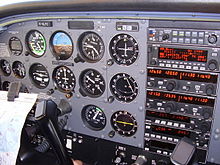 Cessna 172R instrument panel
Cessna 172R instrument panel
General characteristics
- Crew: one
- Capacity: three passengers
- Length: 27 ft 2 in (8.28 m)
- Wingspan: 36 ft 1 in (11.00 m)
- Height: 8 ft 11 in (2.72 m)
- Wing area: 174 sq ft (16.2 m2)
- Aspect ratio: 7.32
- Airfoil: modified NACA 2412
- Empty weight: 1,691 lb (767 kg)
- Gross weight: 2,450 lb (1,111 kg)
- Fuel capacity: 56 US gallons (212 litres)
- Powerplant: 1 × Lycoming IO-360-L2A four cylinder, horizontally opposed aircraft engine, 160 hp (120 kW)
- Propellers: 2-bladed metal
Performance
- Cruise speed: 122 kn (140 mph; 226 km/h)
- Stall speed: 47 kn (54 mph; 87 km/h) (power off, flaps down)[58]
- Never exceed speed: 163 kn (188 mph; 302 km/h) (IAS)[5]
- Range: 696 nmi (801 mi; 1,289 km) with 45 minute reserve, 55% Power, at 12,000 ft
- Service ceiling: 13,500 ft (4,100 m)
- Rate of climb: 721 ft/min (3.66 m/s)
Avionics
- Garmin G1000 Primary Flight Display
See also
- Related development
- Aircraft of comparable role, configuration and era
- Related lists
References
- ^ a b c Russ Niles (2007-10-04). "Cessna to Offer Diesel Skyhawk". http://www.avweb.com/news/aopa/AOPAExpo2007_Cessna_172SSkyhawk_DieselEngine_196294-1.html. Retrieved 2007-10-05.
- ^ Mola, Roger A. (Jul 2006). "Cessna's Golden Oldie". http://www.airspacemag.com/history-of-flight/cessna.html. Retrieved 2009-04-16.
- ^ a b Cessna Aircraft (July 2010). "Pricing and Cost". http://cessna.com/single-engine/skyhawk/skyhawk-pricing.html. Retrieved 2010-07-28.
- ^ a b c Simpson, Rod (June 2009). "Cessna 172 – Simply, the World's Most Successful Light Aircraft?". Air-Britain Aviation World (Air-Britain) 61 (120): 158–163. ISSN 1742-996X.
- ^ a b c Federal Aviation Administration (February 2006). "Cessna 172 Type Certificate Data Sheet" (PDF). http://rgl.faa.gov/Regulatory_and_Guidance_Library/rgMakeModel.nsf/0/263a36336effbcd38625738a004bbe52/$FILE/3A12.pdf. Retrieved 2010-02-21.
- ^ Federal Aviation Administration (November 2004). "Cessna 170 Type Certificate Data Sheet" (PDF). http://www.airweb.faa.gov/Regulatory_and_Guidance_Library/rgMakeModel.nsf/0/51dcd703defaa00486257243006811e2/$FILE/A-799.pdf. Retrieved 2010-02-21.
- ^ [1] AOPA Pilot, May/July 1994
- ^ Time and History 3:53 P.M. Longest Air Flight in History Begins
- ^ a b c d e f g h i j k l m n o p q r s t u v w x y z aa ab ac Clarke, Bill: The Cessna 172 First Edition, pages 31–97. TAB Books, 1987. ISBN 0-8306-0912-1
- ^ a b Phillips, Edward H: Wings of Cessna, Model 120 to the Citation III, Flying Books, 1986. ISBN 0-911139-05-2
- ^ a b c Federal Aviation Administration (March 2003). "TYPE CERTIFICATE DATA SHEET NO. 3A17" (PDF). http://www.airweb.faa.gov/Regulatory_and_Guidance_Library/rgMakeModel.nsf/0/735f374b586fb1e3862572430062e861/$FILE/3A17.pdf. Retrieved 2008-11-13.
- ^ Cessna Aircraft Company (December 2007). "Skyhawk SP Specification and Description". Archived from the original on 2008-03-07. http://web.archive.org/web/20080307232135/http://skyhawksp.cessna.com/specs.chtml. Retrieved 2008-03-09.
- ^ Federal Aviation Administration (February 2008). "TYPE CERTIFICATE DATA SHEET NO. 3A12". http://rgl.faa.gov/Regulatory_and_Guidance_Library%5CrgMakeModel.nsf/0/60FBD5AC1BEE8B08862573ED004D0A45?OpenDocument. Retrieved 2008-03-09.
- ^ There were 172S's produced with standard "steam" gauges, at least in the earlier years.
- ^ Cessna Aircraft Company (2008). "Skyhawk SP Your Next Wing Tips". http://skyhawksp.cessna.com/. Retrieved 2008-03-09.
- ^ Cessna Aircraft Company (2008). "Cessna Skyhawk SP". http://www.cessna.com/single-engine/skyhawk.html. Retrieved 2009-01-29.
- ^ Cessna Aircraft (2007-10-04). "Cessna Skyhawk TD Brochure" (PDF). Archived from the original on 2008-03-08. http://web.archive.org/web/20080308232728/http://se.cessna.com/skyhawktd_brochure.pdf. Retrieved 2007-10-05.
- ^ a b Goyer, Robert: Skyhawk With a Bang, Flying magazine April 2008, pages 64–68. Hachette Filipacchi US Media
- ^ Flying Staff: Parade of Pistons, Flying magazine April 2008, page 4. Hachette Filipacchi US Media
- ^ AvWeb Staff (March 2008). "Thielert Hits Stock Market Turbulence". http://www.avweb.com/eletter/archives/avflash/1077-full.html#197470. Retrieved 2008-03-27.
- ^ Bertorelli, Paul (April 2008). "Thielert's Board is Steamed, and Here's Why That's Not Good". http://www.avweb.com/blogs/insider/AVwebInsiderBlog_ThielertBoardSteamed_197721-1.html. Retrieved 2008-04-24.
- ^ Niles, Russ (April 2008). "Thielert Ousted As CEO". http://www.avweb.com/avwebflash/news/FrankThielert_Ousted_ThielertAG_197611-1.html. Retrieved 2008-03-27.
- ^ Niles, Russ (April 2008). "More Trouble For Thielert". http://www.avweb.com/avwebflash/news/MoreTroubleFor_Thielert_197722-1.html. Retrieved 2008-04-24.
- ^ Aircraft Owners and Pilots Association (May 2008). "Cessna puts diesel airplane line on ice". http://www.aopa.org/aircraft/articles/2008/080501thielert.html. Retrieved 2008-05-02.
- ^ AvWeb Staff (May 2008). "Cessna Suspends Diesel 172 Sales, Diamond Steps Up Support". http://www.avweb.com/avwebflash/news/CessnaSuspendsDiesel172SalesDiamondStepsUpSupport_197780-1.html. Retrieved 2008-05-05.
- ^ Federal Aviation Administration (November 2009). "Supplemental Type Certificate SA01303WI". http://www.airweb.faa.gov/Regulatory_and_Guidance_Library/rgstc.nsf/0/f91e8e02a1e09bc0862576da004fb3ef/$FILE/SA01303WI.pdf. Retrieved 1 August 2011.
- ^ Cessna (2009). "Performance and Specs". http://www.cessna.com/single-engine/skyhawk/skyhawk-performance.html#. Retrieved 1 August 2011.
- ^ Federal Aviation Administration (May 2011). "Type Certificate Data Sheet No. 3A12". http://rgl.faa.gov/Regulatory_and_Guidance_Library/rgMakeModel.nsf/0/66e0e79b9107afb68625788b006ae4da/$FILE/3A12%20Rev%2081.pdf. Retrieved 30 July 2011.
- ^ Grady, Mary (October 2010). "Electric 172 May Fly Early Next Year". AVweb. http://www.avweb.com/news/nbaa/NBAA2010_Electric172MayFlyEarlyNextYear_203463-1.html. Retrieved 20 October 2010.
- ^ Grady, Mary (July 2011). "Electric Cessna 172 Starts Taxi Tests". AVweb. http://www.avweb.com/news/airventure/EAAAirVenture2011_ElectricCessna172StartsTaxiTests_205083-1.html. Retrieved 30 July 2011.
- ^ Irish Air Corps Website – Fleet Pages
- ^ a b Andrade 1982, Page 27
- ^ Andrade 1982, Page 45
- ^ Andrade 1982, Page 57
- ^ Andrade 1982, Page 95
- ^ Andrade 1982, Page 97
- ^ Strategy Page (February 2008). "Iraq Seeks Cessna Solution". http://www.strategypage.com/htmw/htairfo/articles/20080219.aspx. Retrieved 2008-02-19.
- ^ Andrade 1982, Page 61
- ^ Andrade 1982, Page 147
- ^ Andrade 1982, Page 151
- ^ Andrade 1982, Page 172
- ^ Andrade 1982, Page 189
- ^ a b Taylor, John: Jane's Pocket Book of Military Transport and Training Aircraft, page 67. MacMillian Publishing Inc, 1974. Library of Congress 73-15288
- ^ Andrade 1982, Page 193
- ^ Hub Stuff (January 2004). "Just a Day Away". http://www.hubstuff.com/pdf/hubstuff_vol2no6.pdf. Retrieved 13 May 2010.
- ^ Buddyhollyonline (undated). "David Box". http://www.buddyhollyonline.com/related/dbox.html. Retrieved 13 May 2010.
- ^ An Article On Marciano At Check Six
- ^ "Aircraft Accident Report 79-5 (AAR-79-5)" (PDF). National Transportation Safety Board, hosted by PSA history.org. April 20, 1979. http://www.psa-history.org/museum/NTSBAAR7905.pdf. Retrieved 2008-02-16.
- ^ coptercrazy (undated). "Listing of Production Reims F172". Archived from the original on 2005-03-14. http://web.archive.org/web/20050314122837/http://www.coptercrazy.scsuk.net/production/rcessna/172/f172-42.htm. Retrieved 2007-12-23.
- ^ Aviation Safety Network (July 2009). "Accident Description". http://aviation-safety.net/wikibase/wiki.php?id=42107. Retrieved 2009-07-28.
- ^ "Stolen Cessna's Pilot Captured". http://abcnews.go.com/Technology/story?id=7273710&page=1. Retrieved 2009-04-06.
- ^ Canadian Broadcasting Corporation (April 2009). "Pilot charged after plane leads U.S. fighter jets over 4 states". CBC News. http://www.cbc.ca/world/story/2009/04/07/ont-pane-theft.html. Retrieved 2009-04-07.
- ^ Niles, Russ (April 2009). "Pilot Arrested After Plane Chase". http://www.avweb.com/avwebflash/news/PilotArrestedAfterPlaneChase_200094-1.html. Retrieved 2009-04-07.
- ^ Niles, Russ (April 2009). "School Reviews Security After 172 Theft (Corrected)". http://www.avweb.com/avwebbiz/news/SchoolReviewsSecurityAfter172Theft_200104-1.html. Retrieved 2009-04-07.
- ^ Canadian Broadcasting Corporation (November 2009). "Canadian jailed for flying stolen plane into U.S.". CBC News. http://www.cbc.ca/world/story/2009/11/03/pilot-jailed-stolen-plane.html. Retrieved 2009-11-04.
- ^ Cessna (2009). "Cessna Skyhawk Performance". http://www.cessna.com/single-engine/skyhawk/skyhawk-performance.html. Retrieved 22 August 2010.
- ^ Cessna (May 2010). "Skyhawk 172R Specification and Description". http://textron.vo.llnwd.net/o25/CES/cessna_aircraft_docs/single_engine/skyhawk/skyhawk_s&d.pdf. Retrieved 22 August 2010.
- ^ Jackson 2003, pp. 588–589.
- Andrade, John (1982). Militair 1982. London: Aviation Press Limited. ISBN 0-907898-01-7.
- Jackson, Paul (2003). Jane's All The World's Aircraft 2003–2004. Coulsdon, UK: Jane's Information Group. ISBN 0-7106-2537-5.
External links
Cessna aircraft Single-engine A · AA · AC · AF · AS · AW · BW · CR-2 · CR-3 · CW-6 · EC-1 · EC-2 · DC-6 · C-34 · C-37 · C-38 · C-145 · C-165 · 120 · 140 · 150 · 152 · 160 · 162 · 170 · 172 · 175 · 177 · 180 · 182 · 185 · 187 · 188 · 190 · 195 · 205 · 206 · 207 · 208 · 210 · 305 · 308 · 309 · 319 · 321 · 325 · 350 · 400 · 1014 · 1034 · NGP · XMC
Multi-engine Cessna Citation
familiesHelicopters Gliders Military Lists relating to aviation General Aircraft (manufacturers) · Aircraft engines (manufacturers) · Airlines (defunct) · Airports · Civil authorities · Museums · Registration prefixes · Rotorcraft (manufacturers) · TimelineMilitary Accidents/incidents Records Categories:- Cessna aircraft
- High wing aircraft
- Propeller aircraft
- Single-engine aircraft
- United States civil utility aircraft 1950–1959
- 1956 introductions
Wikimedia Foundation. 2010.


